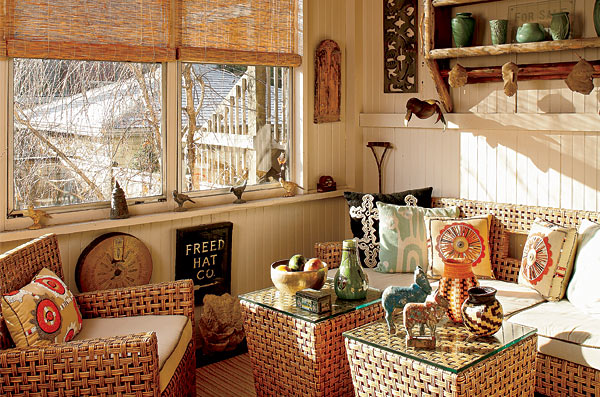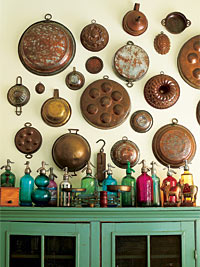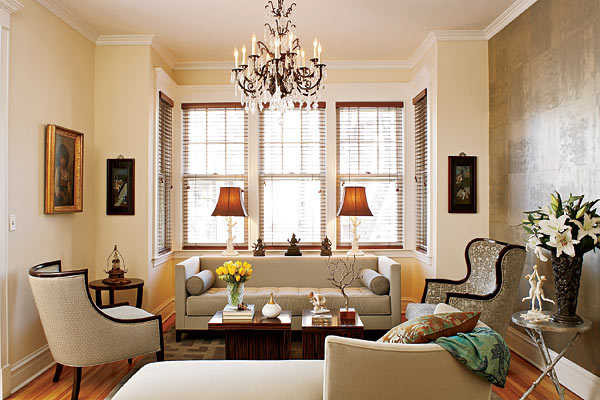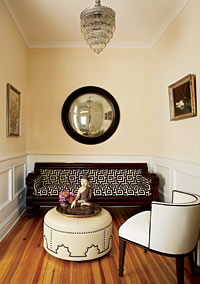
Tom Hamilton’s sense of humor extends to his enclosed porch, where petrified wasps’ nests and a bird made of coconuts hang from a rustic wooden shelf. Large-weave rattan furniture strikes an outdoorsy note. Photo Gallery »
Tom Hamilton’s Edgewater home is one of those houses you drive by, do a double take, and back up to see again. It’s like something out of a child’s storybook—the modest farmhouse that kept to itself while a big city grew up around it. “People love to tell me how ‘out of place’ my little house is,” says Hamilton of the way his cozy 1890s cottage sits sandwiched between two bland brick 1920s three-flats.
As gaslight-era relics go, his house has been unusually lucky. Hamilton bought the place when he was just 21, and through 20 years of ownership he has never considered a massive overhaul. Quirks like the rickety, off-kilter stairs make him happy. “It would take so much away from the character of the house to take them out,” he says.
The unsightly siding he inherited was another matter. “It was gray roofing shingles,” Hamilton recalls. “One day I was curious to see what was underneath, so I tore them off and opened a whole can of worms.” That was eight years ago, and what he discovered underneath the shingles was a lost world of architectural detail. “Then,” he says, “I couldn’t turn back.”

In the kitchen, Hamilton displays vintage copper pans and molds above antique soda-water bottles he collected in Argentina. Photo Gallery »
With its original façade restored, the house looks impossibly charming sitting behind a postage-stamp garden and tiny patch of lawn. Its vibrant red door (chosen to stand out) opens onto an interior almost as surprising as the exterior. Hamilton isn’t just another impassioned neighborhood preservationist; he’s a professional freelance prop stylist who has staged photo shoots for clients as diverse as Kraft, The Pampered Chef, and the Art Smith–authored Back to the Family publisher. Working out of Chicago, Hamilton drew the attention of the talent scouts at Harpo Productions, who recruited him for what turned out to be an eight-year freelancing gig staging the Oprah Winfrey Show.
Peering around this beguiling rabbit warren of a house that Hamilton shares with his partner, Juan Palomino, you see a perfectly orchestrated mélange of the beautiful, the unusual, and the downright odd. There’s nothing off-the-shelf precious about this place; the statements it makes are deeply personal. “I’m a somewhat reserved person,” admits Hamilton. “My house says so much more about me than I could ever reveal with words.”
The first thing it reveals is that Hamilton has been an on-again, off-again antiques dealer since he was 16 years old. “In college, other kids were going to keggers; I went antiquing,” he says. In fact, he was still in college when he found the massive Empire sofa that greets visitors in what he calls his “Greek neoclassical foyer.” Today it’s upholstered in a modern graphic print, but at one point this elegant sofa actually lived in student housing (“I was trying to create beauty even back then”).
Beauty, as defined by this stylist, is rarely conventional. Take the vibrant botanical prints dominating one wall of his eat-in kitchen. Not your everyday pretty florals, these highlight plant cell structure and photosynthesis. Hamilton bought 300 of them from a South Side flea-market vendor who was liquidating outdated teaching aides from a high-school science lab in Joliet. Hamilton promptly resold 40 of them to shopkeeper Larry Vodak, of Andersonville’s Scout, and set the rest aside for himself.
“They have so much impact grouped together like this,” says Hamilton, who paired the arrangement with a pendant light fashioned from an old gas-pump crown found on his grandfather’s Wisconsin farm. “Certain things just speak to me—I couldn’t begin to tell you why,” he says with a shrug.
Photography: Alan Shortall
Styling: Tom Hamilton
Related:

In the living room, Hamilton was going for “1940s Hollywood glamour”; a monochromatic color palette highlights items such as the 19th-century bronze Indian Buddhas silhouetted against the window. Photo Gallery »
Among those things are some colorful majolica plates Hamilton found in a Warsaw flea market; they run across the soffit over the kitchen cabinets, tapering off into a collection of vintage copper baking pans and molds that fill the last remaining bit of wall space. “My house isn’t a decorator statement,” says Hamilton. “No one comes in and wonders, ‘Who did this place?’”
The only pause in this parade of objets occurs in the living room, where Hamilton chose to cover one side of the room, baseboard to cornice, in a silvery wallpaper. “I wanted one wall where I didn’t feel pressure to put anything on it at all,” he says. “I wanted a wallpaper so good-looking, I wouldn’t feel guilty if I didn’t cover it up.”
It’s not surprising Hamilton needed to force himself to take a break from orchestrating and organizing; not even the books on his living room coffee table escape his scrutiny. “This top book isn’t just any book,” he notes. “Its cover is a landscape, so this little Austrian bronze figure set on top is sort of immersed in the scene.”

An antique Thai Buddha greets visitors in the foyer, which doubles as a sitting room. A crisp modern fabric freshens an Empire sofa. Photo Gallery »
Every vignette triggers a memory for this inveterate traveler. Hamilton takes two months out of every year to go global foraging—thus, treasures such as the carved wooden head from an open-air Belgian market that sits in his upstairs “book nook,” a religious incense burner from Darjeeling that rests on a living room end table, and (a special favorite) the 80-year-old ceremonial mask from Mumbai that presides over the den. “If I could have bought a whole wall of those masks I would have,” says Hamilton. “I love India’s chaotic beauty, its sensory overload. I clearly like order, but it’s exhilarating and inspiring to see there’s such beauty in chaos, too.”
A master of juxtaposition, Hamilton has dressed a shelf on an enclosed porch off the kitchen with green Mission-style pottery, birds made from coconuts, and petrified wasps’ nests. “You might not think of wasps’ nests as decoration,” he says. “This is more about the play of color, pattern, and texture, like the look of these turquoise pillows against the matte pottery. It’s about making little vignettes so your eye is forced to travel from one to another.”
So was it nature or nurture that trained Hamilton’s eye? The 18th-century Japanese block prints he built his “Asian dining room” around hold the answer. They belonged to Hamilton’s late grandmother, Mitzi Bernauer, and his 1940s Hollywood-glam living room is a kind of homage to her.
“My brother walked in and said, ‘This is amazing, just like her house,’” Hamilton says. The wall of silvery wallpaper pulls light into the room and softly reflects the slew of treasures Hamilton inherited from très chic Mitzi—Meissen porcelains, Asian eglomise paintings, 19th-century Buddhas, and an English bench with an embroidered cushion.
“These are objects I found beautiful as a kid, and for 30 years I’ve thought they were beautiful,” Hamilton says. “I think of this house as my little cocoon. I’m not a man of words and people might find it hard to get to know me, but when they walk into my house, it all comes together.”
Photography: Alan Shortall
Styling: Tom Hamilton
Related:



